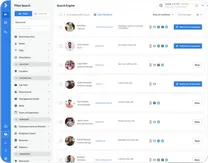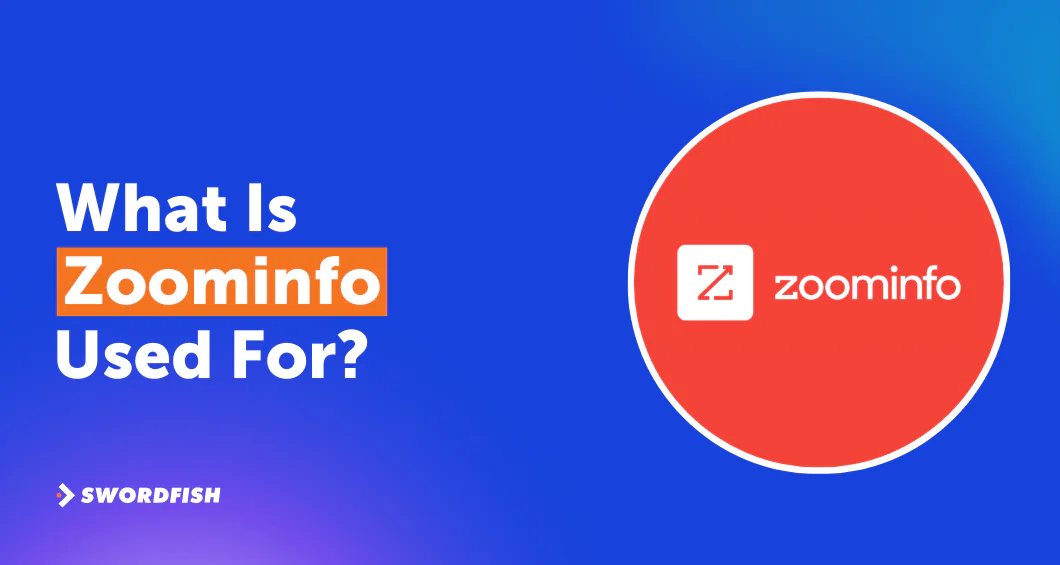
More than 260M professional profiles were processed, and 34M company profiles were processed only outside North America. ZoomInfo has a lot going on. You can use it for anything ranging from sales intelligence to account-based marketing.
And there are several more of its uses. But at its core, what is ZoomInfo used for?
ZoomInfo is primarily used to improve sales, marketing, operations, and recruitment strategies with its deep database and analytics. It excels in account-based marketing, unlocking insights, enrichment, engaging customers, and accelerating success.
As we dive deeper into the specifics of how ZoomInfo powers different sections of business—from pinpointing potential clients to refining recruitment processes—keep reading to find and learn about the details of its capabilities.
What is ZoomInfo?
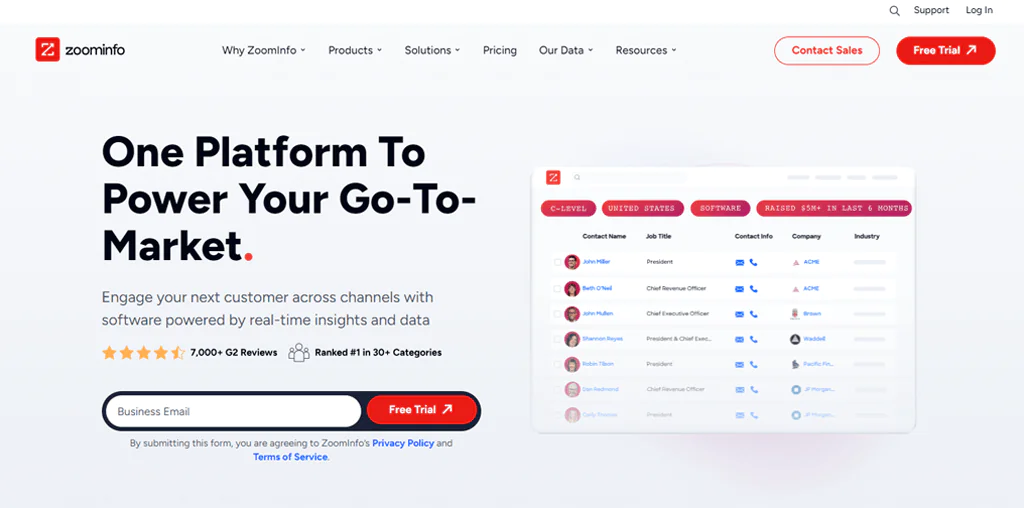
ZoomInfo is a cloud-based, lead generation platform that provides comprehensive information on businesses and professionals. It helps users find, connect, and engage with their target audience through detailed company profiles, contact data, and market insights.
ZoomInfo was initially founded as DiscoverOrg in 2007 by Henry Schuck. His main purpose was to help businesses grow to their full potential through superior data.
In 2019, DiscoverOrg acquired ZoomInfo, and came in with unparalleled B2B intelligence. By 2020, ZoomInfo solidified its market presence by going public, marking a significant milestone as the largest software IPO of the decade.
Today, ZoomInfo equips GTM teams to reach out, win over, and grow at an unmatched pace by providing unified tools for sales, marketing, and operations.
The platform grants access to a wide range of company, contact, and intent data, making it easier for teams to run joint campaigns and automate their outreach efforts worldwide, even beyond North America.
How Does ZoomInfo Get Their Data?
ZoomInfo is known for its detailed database with over 600 million professional profiles and 1.3 billion company profiles. This wealth of information is needed for sales or marketing teams, but how ZoomInfo collects this data is equally important. Here’s a look at their process:
Here is how ZoomInfo get their data –
Collecting Broad Information
ZoomInfo pulls its data from many places, like online platforms and specialized third-party providers, plus it benefits from contributions from a community network. This approach ensures a vast and rich database filled with business information and buying signals.
Refining and Verifying Data
ZoomInfo turns billions of raw data points into useful insights by using a detailed verification process. It employs Natural Language Processing (NLP), Artificial Intelligence (AI), Machine Learning (ML), and data scientists to make sure the data is accurate and relevant. This verification happens in real-time, keeping the data up-to-date and useful.
Keeping Data Current
ZoomInfo constantly tests, updates, and checks its data to give go-to-market teams the latest information. They quickly adjust, add, or remove data as changes occur, ensuring the database stays fresh and reliable.
In our review of ZoomInfo, we’ve noticed its strong commitment to data quality, reinforced by strict security and privacy standards. This means the data you get is accurate and respects privacy laws.
What is ZoomInfo Used for?
ZoomInfo is primarily used by sales, marketing, operations, and recruitment teams to access comprehensive business and contact data for lead generation, market analysis, data enrichment, and talent sourcing.
Let’s talk about each usage in detail –
1. ZoomInfo is Used for Sales
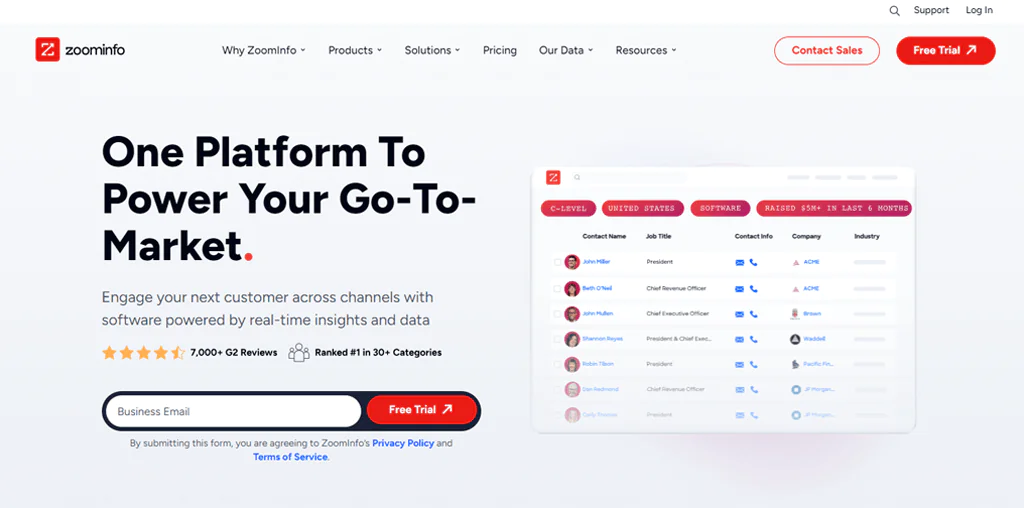
ZoomInfo SalesOS gives sales teams the much-needed features and tools, each carefully made to help drive your sales reach and efficiency.
At its core, SalesOS offers enough access to a contact database that has over 70 million direct dial phone numbers and 174 million verified email addresses.
This resource allows sales professionals to have their account lists fine-tuned and more precise. Firstly, the sales part of ZoomInfo is used to align with their Ideal Customer Profiles (ICPs) and ensure they connect directly with key decision-makers.
Let’s find out what ZoomInfo Sales OS uses –
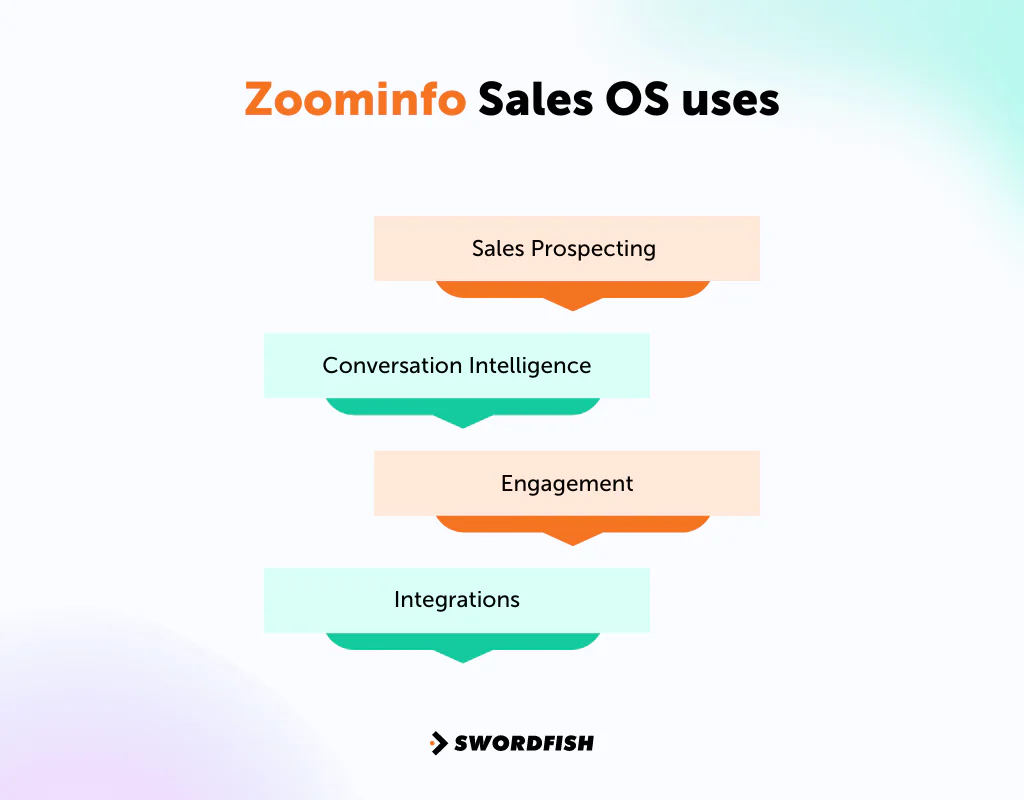
Sales Prospecting
Sales Prospecting is a key feature of SalesOS, designed to fine-tune your search for new customers. It uses detailed data and signals to show you which companies are likely to buy soon, making your prospecting efforts much more focused.
ZoomInfo Intent takes this a step further by providing sales teams with specific details about potential buyers who are actively looking for solutions. This feature works by tracking over 210 million connections and more than 6 trillion searches to find interested buyers.
This valuable data helps your team find and focus on prospects that are ready to engage, making your sales approach more effective across different channels.
Additionally, ZoomInfo’s WebSights tool turns anonymous website visits into real sales leads by identifying which companies are visiting your site. This helps you know who is interested in your products, allowing direct contact with decision-makers who are more likely to buy.
Conversation Intelligence
Conversation intelligence is a game-changer in sales, turning every interaction with customers into a chance to learn and improve. It dives deep into calls, meetings, and emails to offer insights that help you refine how you sell.
With this info, you can figure out the best strategies and tweak your approach for better success.
A key feature within this is the Chorus. Chorus, backed by 14 machine learning patents, revolutionizes sales conversations. It analyzes the details of customer interactions, offering insights into what strategies are hitting the mark and which ones aren’t. This insight is crucial for refining your sales pitch.
Chorus is also invaluable for training and ramping up new sales staff. It identifies the actions that result in sales success, helping newcomers learn effective tactics quickly.
This ensures your whole team knows and uses the strategies that work, keeping your sales efforts sharp and successful.
Engagement
You can then use engagement tools within SalesOS to create more meaningful conversations that lead to conversions. From email and phone automation to website chat, these tools make it easy for you to connect with potential customers across all channels.
Whether it’s automating outreach to keep your pipeline filled or engaging visitors on your site with real-time chat, these features work together to make every interaction count. You can even make the most of its contact tracking and teams monitor your key contacts closely.
This feature is used for maintaining strong relationships, understanding the dynamics within accounts, and identifying when changes occur that could influence existing business or uncover new opportunities.
It doesn’t end there. You also have ZoomInfo Chat which further shortens the sales cycle by integrating a data-driven chat tool that engages best-fit buyers in real-time.
Integrations
Here’s a table categorizing four tools each for sales, marketing, recruiting, and team preferences with their respective features –
|
Category |
Tool |
Features |
|
Sales |
Salesforce |
CRM |
| Zoho CRM |
CRM |
|
|
People.ai |
Relationship Intelligence, Sales Engagement & Intelligence, CRM | |
| Gong Engage |
Sales Engagement & Intelligence, Revenue Intelligence |
|
|
Marketing |
Marketo |
CRM, Marketing Automation |
|
Eloqua |
CRM, Marketing Automation | |
| HubSpot |
Dialer Automation, CRM, Marketing Automation |
|
| Recruiting |
Salesforce for TalentOS |
CRM |
| JazzHR |
Applicant Tracking System (ATS) |
|
|
JobAdder |
Applicant Tracking System (ATS) | |
| Zoho Recruit |
Applicant Tracking System (ATS) |
|
|
Team Picks |
Gong Engage |
Sales Engagement & Intelligence, Revenue Intelligence |
| People.ai |
Relationship Intelligence, Sales Engagement & Intelligence, CRM |
|
|
Databricks |
Data Warehouse | |
| Eloqua |
CRM, Marketing Automation |
This table showcases a selection of tools available in the ZoomInfo Marketplace.
Integrations push your sales velocity to new heights. This synergy allows for the automation of routine tasks, letting your sales team concentrate on what they do best: selling.
Plus, you can also make do with Workflows. With this, you can swiftly respond to market signals like buyer intent and funding news, automating outreach and sales activities to keep pace with the market’s pulse.
Then, a part of their integration usage is data enrichment which takes your market understanding to the next level. By integrating ZoomInfo’s rich, reliable B2B data into your CRM and marketing automation platforms, you maintain up-to-date and accurate data.
2. ZoomInfo is Used for Marketing
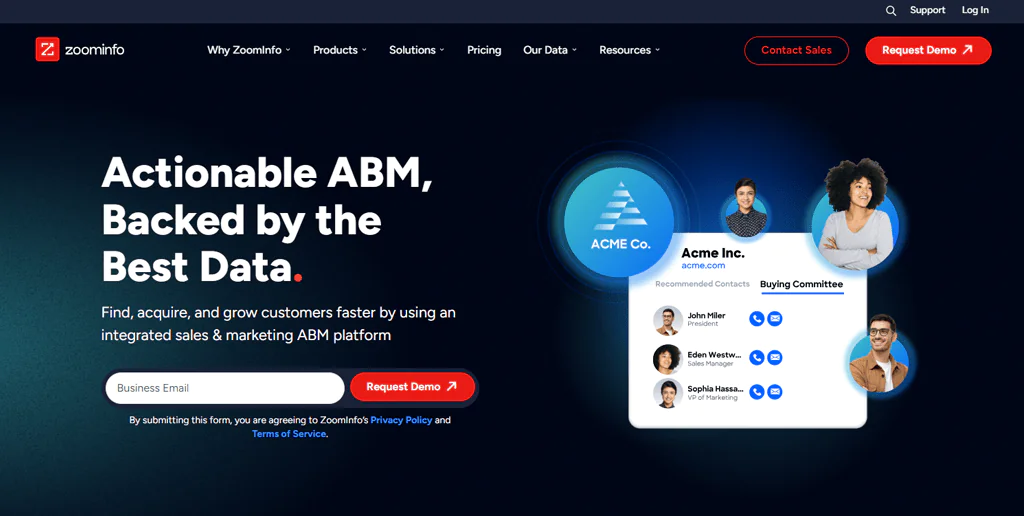
ZoomInfo for Marketing is your go-to for making meaningful connections with your audience. You can mainly use it to make sure those messages you are sending out land with the right people at the right time.
With access to over 104 million company profiles and 600 million contact profiles, plus insights into more than 4,900 company attributes, marketing teams have enough with them to design campaigns that truly resonate.
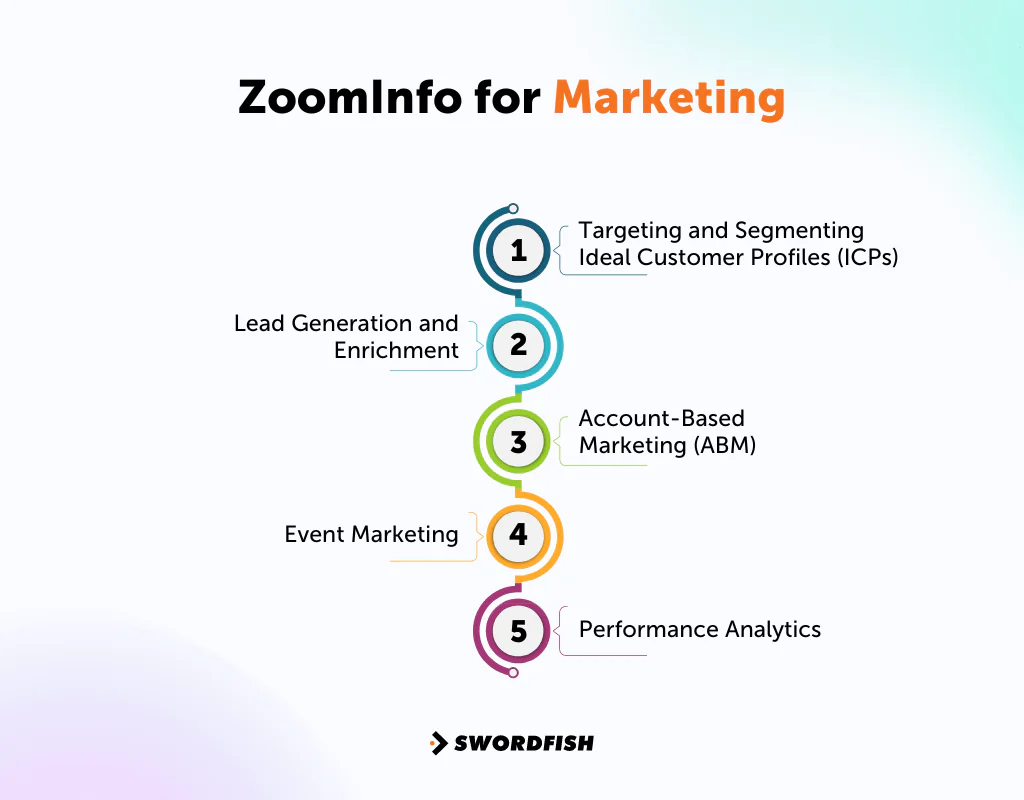
Targeting and Segmenting Ideal Customer Profiles (ICPs)
By diving into ZoomInfo’s vast database, you can precisely pinpoint your ideal customer profiles. This means you are focusing your efforts where they’ll make the biggest impact.
Using this makes it easier for you to understand the specific characteristics of your target audience. Now, you can customize your messaging to meet their needs and interests, making every campaign more effective.
Lead Generation and Enrichment
Generating leads is just the beginning. With ZoomInfo, you can enrich those leads with detailed, up-to-date information and give yourself the assurance that your outreach is always relevant.
From direct dial numbers to email addresses, all verified for accuracy: You can have a constant stream of fresh data at your fingertips. This level of detail transforms how you engage with potential customers, which makes every interaction count.
Account-Based Marketing (ABM)
ABM is precision, and ZoomInfo gives you the tools to execute it flawlessly. By offering details about the companies most likely to convert, you can create personalized marketing plans that speak directly to their needs.
Plus, they have a focused approach. Something that not only strengthens relationships with key accounts but also shortens the sales cycle, driving growth more efficiently.
Event Marketing
Whether hosting a webinar or an in-person event, knowing who to invite is half the battle. ZoomInfo helps you identify potential attendees based on their interests and engagement likelihood so that your event has the right audience.
With the most accurate IP-to-company graph in the world, analyzing over 6 billion IP addresses, your follow-up campaigns are more likely to convert. This is just the right feature to be used when you wish to turn attendees into leads.
Performance Analytics
In marketing, what gets measured gets improved. ZoomInfo’s analytics tools let you track the success of your campaigns in real time.
More than the numbers, you get the necessary insights that guide your strategy, helping you understand what resonates with your audience and why. With this knowledge, you can continuously refine your approach.
3. ZoomInfo is Used for Operations
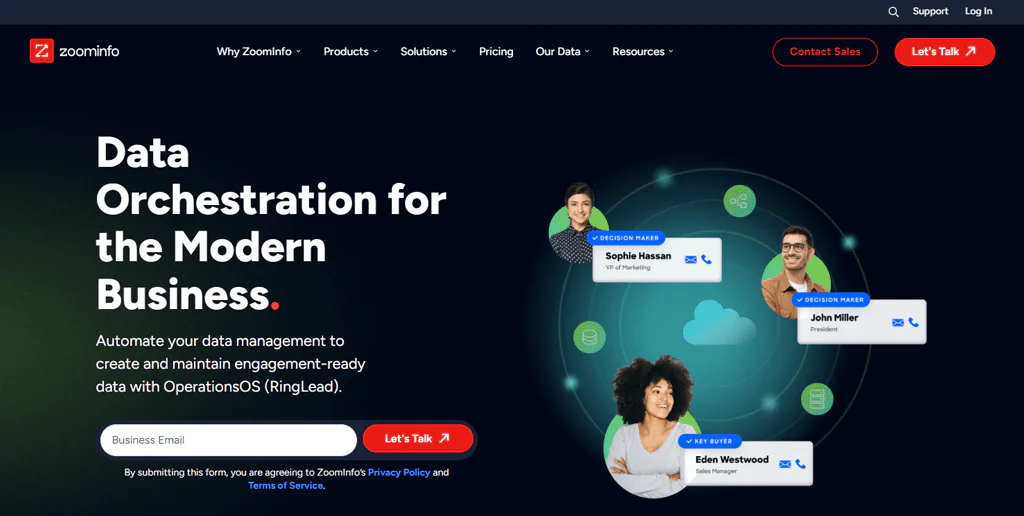
ZoomInfo OperationsOS transforms the complex data management task into a simple process and ensures your data is always ready for engagement. This platform is useful for businesses looking to automate their data orchestration, making data management a breeze.
Here are its main uses –
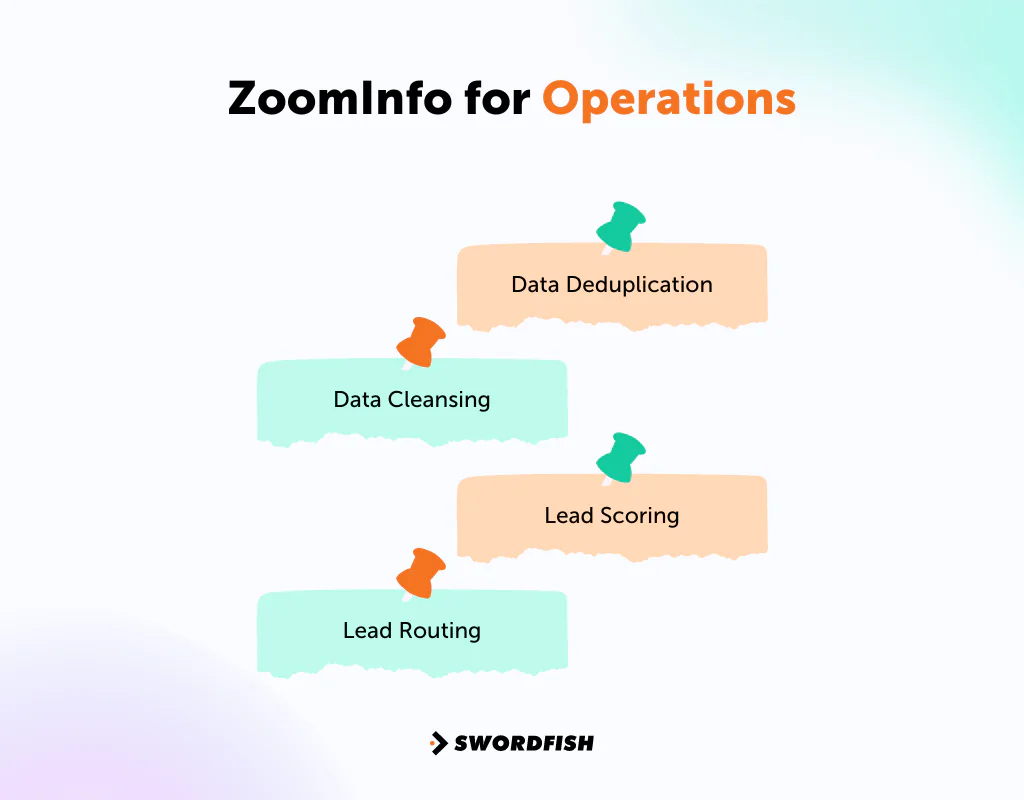
Data Deduplication
Data Deduplication is a smart feature in OperationsOS that helps keep your data clean by automatically finding and combining any duplicate records. This means you end up with a more organized database, saving time and avoiding confusion from having several copies of the same contact or account information.
With the ability to set your own rules for how duplicates are identified and merged, OperationsOS ensures your data is always accurate and dependable.
This attention to maintaining data quality is one reason why ZoomInfo’s pricing might be higher, but it’s a valuable investment for keeping your information streamlined and effective.
Data Cleansing
Next up is the data cleansing feature of OperationsOS. You can use this to correct errors and inconsistencies in your data.
An intuitive drag-and-drop interface standardizes and normalized data elements like phone numbers and company names. End of the use, you have your records uniform and actionable.
This automated cleansing process means that your team can trust the data they use daily!
Lead Scoring
Lead Scoring within OperationsOS helps prioritize your leads and accounts based on their potential value to your business.
By segmenting leads using criteria such as job function, seniority, and industry, you can focus your efforts on those most likely to convert.
Something that many ZoomInfo competitors don’t have is that the platform offers various scoring models, including account-based scoring and intent-based scoring. Each can be used to customize your approach to different market segments and maximize the efficiency of your high-performing sales funnel.
Lead Routing
OperationsOS takes the guesswork out of lead routing. You can use this feature to make sure that leads are quickly assigned to the most appropriate sales rep.
This feature automates territory management and uses a round-robin distribution system to allocate leads fairly. What does this mean? Shortened sales cycle and optimized conversion rates.
With OperationsOS, you can monitor the lead distribution process in real-time, and know that every lead is followed up promptly and effectively.
ZoomInfo for Recruitment
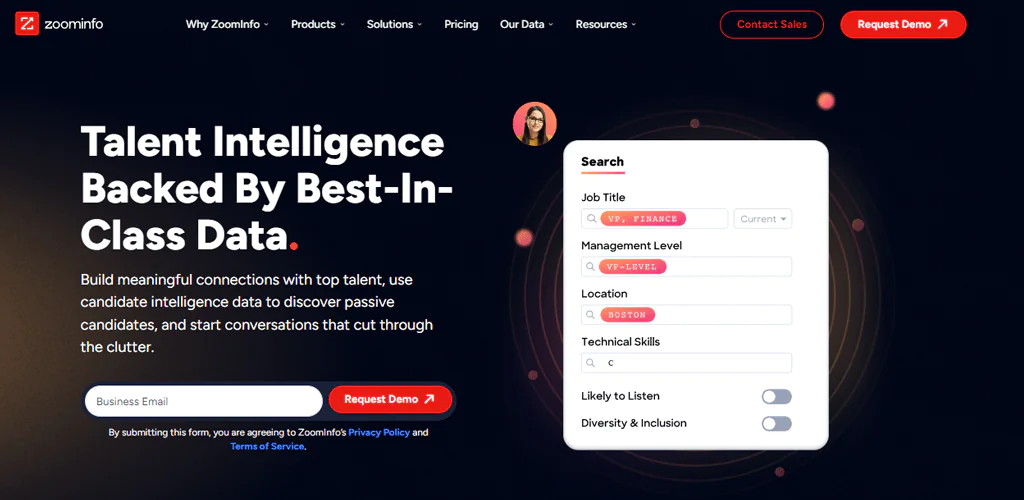
ZoomInfo TalentOS changes the way recruiters source talent.
You have direct access to detailed candidate and company intelligence. So, if you are a recruiter, you can now pinpoint individuals ready for new opportunities using specific search filters, including company firmographics and organizational charts.
You can use it to discover organizations in need of staffing services and connect with key decision-makers through a comprehensive recruiting database. We’re talking over 65 million direct dial numbers and 155 million verified email addresses.
You can also utilize it for detailed company pages for business development insights, including a company’s revenue, significant updates, employee numbers, and more, available across 106 million companies.
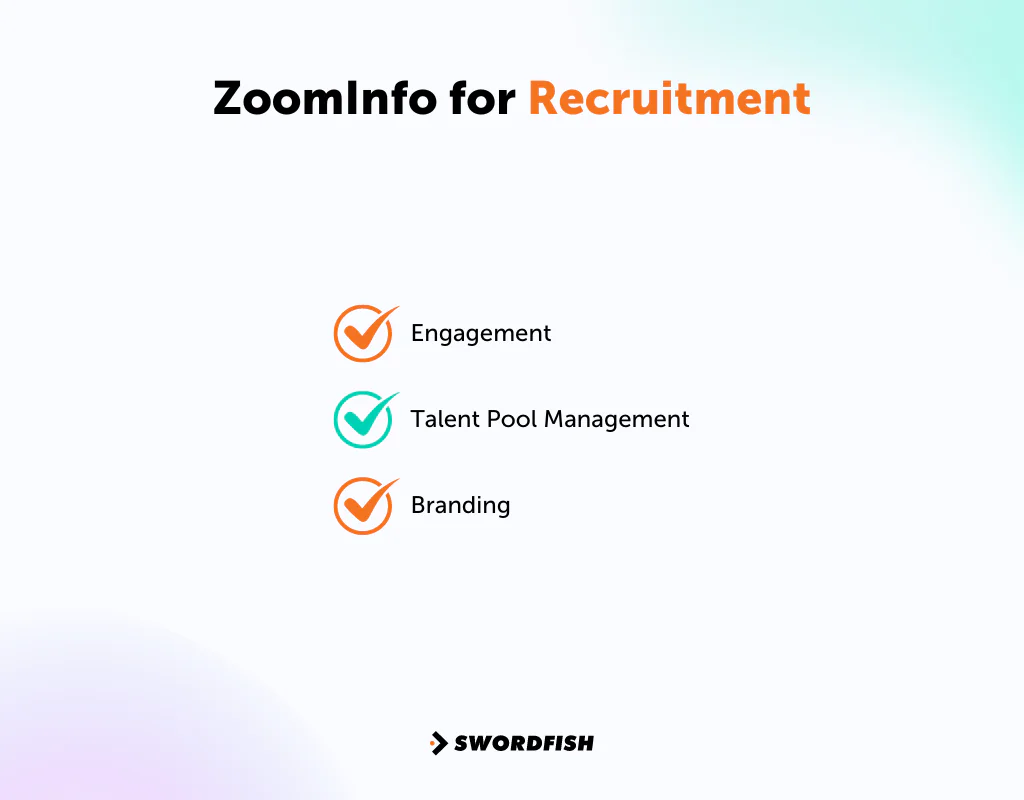
Engagement
Engagement in recruitment is used for making meaningful connections, and TalentOS by ZoomInfo brings this to the forefront. The platform aids recruiters like you to build automated touchpoints. What you eventually get is increased chances of hiring and reduced time-to-fill for positions.
Whether it’s through personalized emails or auto-dialer calls that create a personal connection, TalentOS is heavily used to ensure that your message reaches the right candidates.
And then there’s Drip campaigns which combine these methods into automated sequences, touching base with candidates through multiple channels. All of which improves your recruitment strategy and your chances of engaging with top talent.
Talent Pool Management
Managing your talent pipeline is an aspect of recruitment that needs attention. TalentOS offers complete tools to make this process as efficient as possible.
Projects allow recruiters to organize searches by open roles and build multiple talent pools for each job. This means you can use it to facilitate collaboration and tracking as candidates move through the hiring stages.
You can’t ignore TalentOS Chrome Extension, which can also be used to view candidate data while sourcing across the web and take immediate action on best-fit candidates.
Moreover, ATS integrations save you so much time. What you can do is export top candidates directly into your ATS or CRM. Cleaning out the clutter in the process and saving more time.
Branding
The job market is competitive, and building a strong employer brand is much needed. TalentOS helps companies collect employee reviews and testimonials to soar their online reputation and create compelling recruitment marketing collateral.
This platform not only provides access to top candidates but also offers information about their current companies. More and more customization!
By combining various resources into one platform, TalentOS is used to make everything recruiters need readily available.
ZoomInfo Pricing
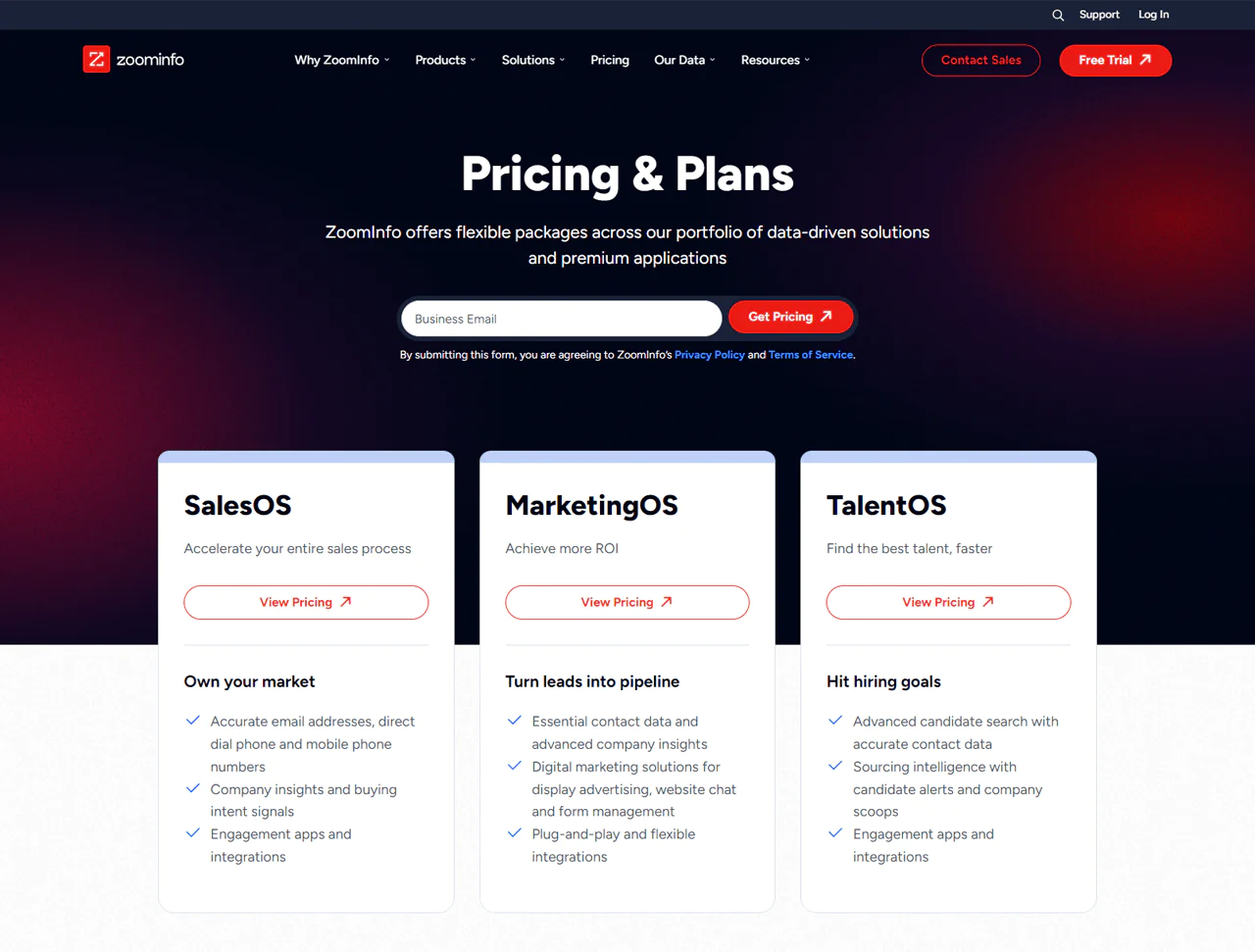
ZoomInfo’s pricing depends on the chosen features, the number of licenses, and how much credit is used. It offers SalesOS, which provides sales teams with contact information and insights on potential buyers.
MarketingOS helps in digital marketing efforts with needed data and tools, while TalentOS supports recruitment with comprehensive candidate information and notifications.
Exact pricing details for ZoomInfo are not publicly disclosed, but we have gathered some insights from various sources. The pricing for ZoomInfo starts with:
- The Pro+ Plan, which is aimed at meeting a variety of business requirements, begins at $8,000 per year.
- The Advanced Plan, which offers more benefits, including 1,000 monthly credits for each user, is set at $12,000 annually.
- The Elite Plan offers the highest level of data access and features and is available for $40,000 annually.
Looking for a Better Alternative to ZoomInfo? Try Swordfish AI
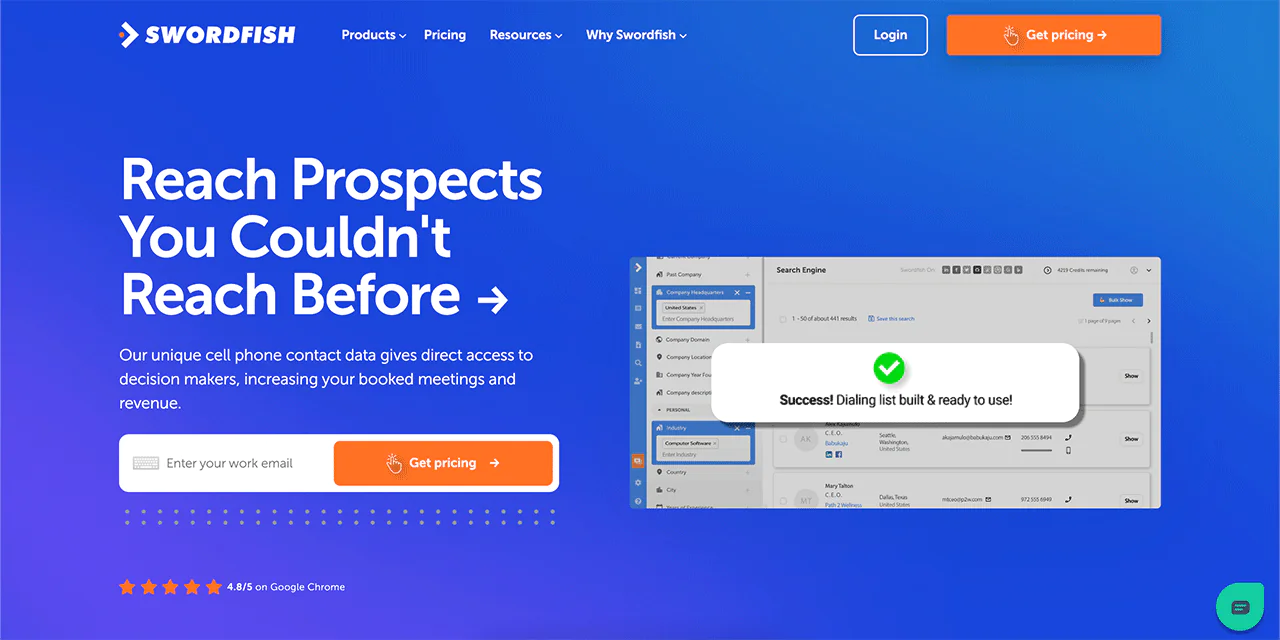
Swordfish AI, with its advanced proprietary algorithm, is one of the top lead generation tools. We employ a system that makes sure that the verification of cell phone numbers is prioritized before anything.
Unlike our competitors, such as ZoomInfo, Swordfish AI prioritizes providing verified, up-to-date cell phone numbers alongside exclusive business email data. Plus, we offer an exclusive algorithm to sift through all the data to keep on the most relevant ones.
This focus on accuracy is quite evident, too. We have a success rate of 82% on the first call and 92% across profiles. And that is due to the incredible 3.5 billion profiles that we have.
Trusted by over 50,000 professionals, Swordfish AI combines reliable data, responsive customer service, and adaptable pricing plans, making it a superior choice for Sales Development Representatives (SDRs) seeking precise contact information and effective outreach strategies.
Comparison Table: ZoomInfo Vs Swordfish AI
Here’s a table to show how the two compare –
|
Aspect |
Swordfish AI | ZoomInfo |
| Pricing | Custom pricing available |
Varies based on functions, licenses, and credits. Options include SalesOS, MarketingOS, and TalentOS. |
|
Database Size |
3.5 billion data points with exclusive cell phone data and premium business emails. | 260 million professional profiles, and 1.5 billion data points. |
| Sales Prospecting | Offers 33%+ more cell phone numbers for direct sales prospecting. |
Features Conversation Intelligence; prospecting backed by 14 technology patents. |
|
Chrome Extension |
Seamless syncing with CRM and ATS. | Supports sales engagement, Dialer Automation. |
| Marketing Campaigns | Includes Bombora® Intent Data for identifying ready-to-purchase businesses. |
Uses an intent engine with signals from 210 million IP to Org Pairings and over 6 trillion keyword-to-device pairings. |
|
CRM Integration |
Integrates with CRM platforms; features include Salesforce Sync, Zapier, Pipedrive. | Extensive ATS integration; categorized apps like People.ai, Marketo, Cloudtalk, with an app market available. |
| Unique Features | Cell phone verification system, Chrome Extension, API, Reverse Search. |
Website chat, Data as a Service, API and Webhooks, Employer Branding. |
Key features of Swordfish AI
If we compare ZoomInfo and Swordfish, there’s a lot that Swordfish AI offers. Here are our key features –
-
Chrome Extension
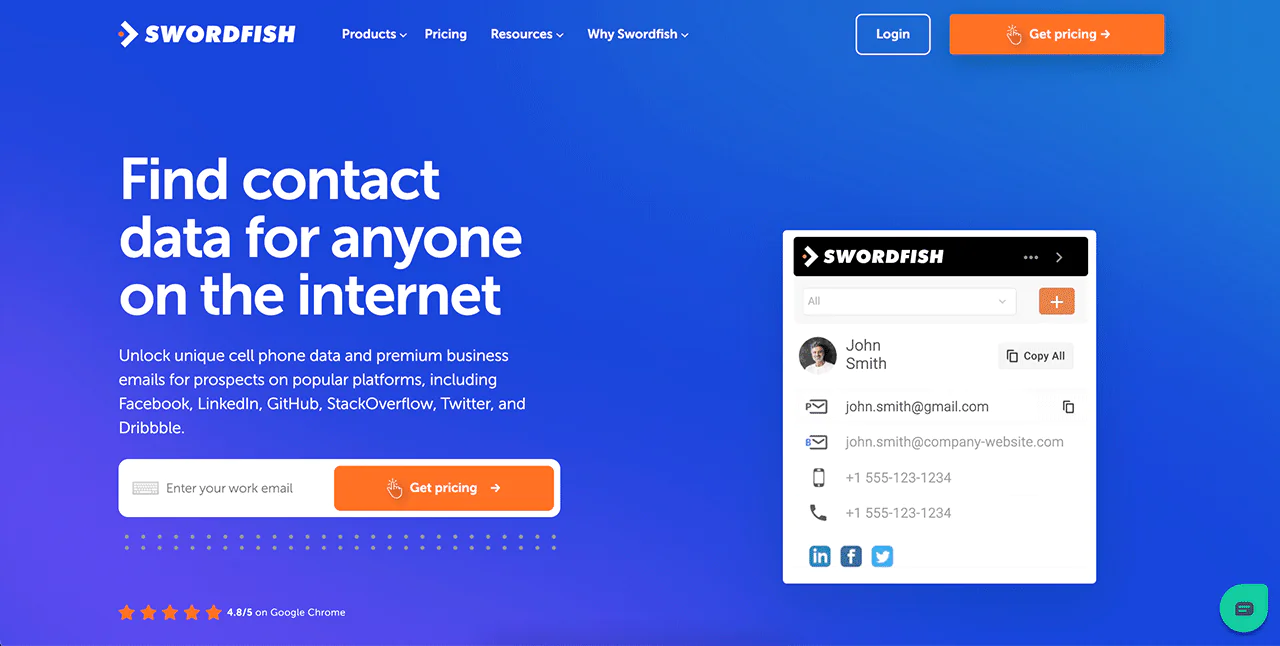
The Chrome Extension allows you to effortlessly extract contact details directly from platforms such as Facebook, Twitter, and LinkedIn. It’s surely a time-saver, removing the need to switch between tabs or applications.
-
Prospector Tool
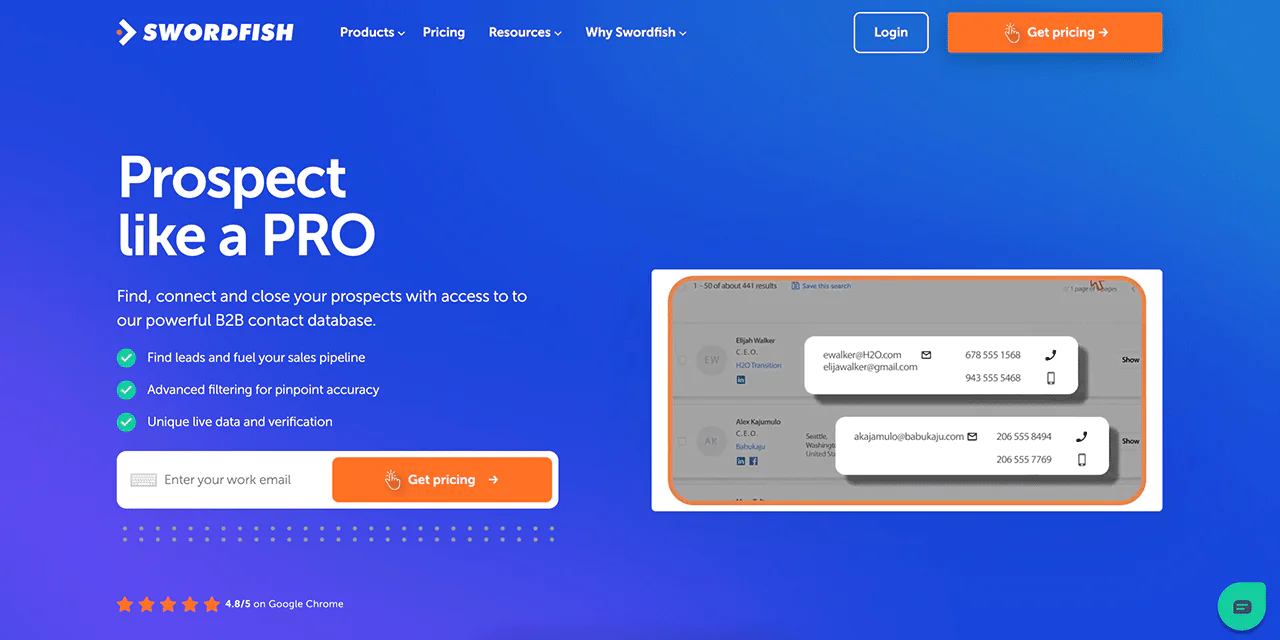
Beyond just finding contacts, the Prospector Tool allows you to generate specific dialing or email lists quicker than ZoomInfo. Our advanced filters guarantee that the lists are tuned to your needs.
-
Bombora Intent Data
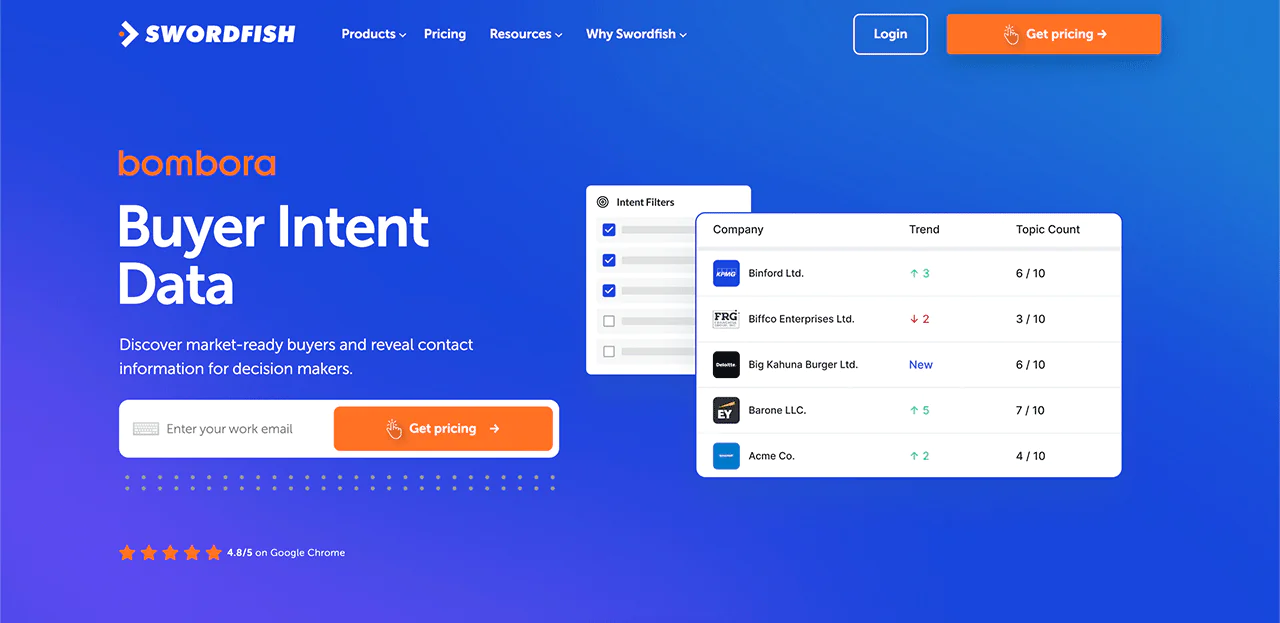
Swordfish AI uses Bombora Intent Data to pinpoint companies that are ready to buy. This key information helps sales teams zero in on leads with a higher chance of making a purchase, making your efforts more effective.
-
File Upload
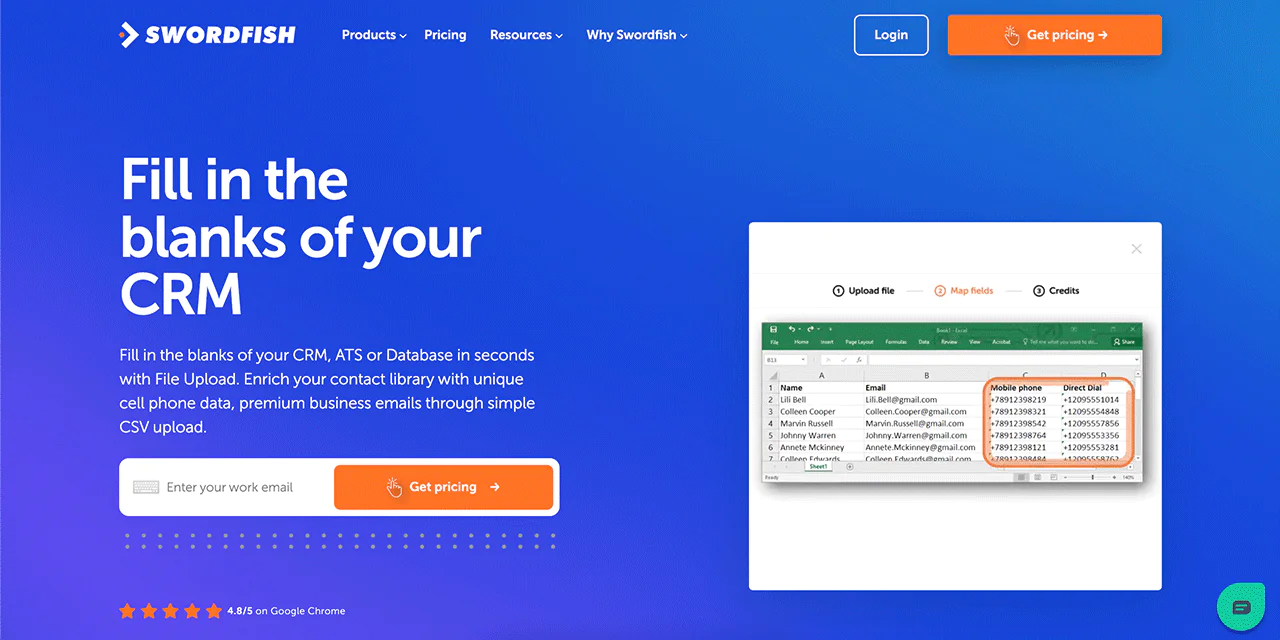
If you have a CRM with gaps in contact details, Swordfish has you covered. By uploading a CSV file, the platform can fill in those missing pieces of information, ensuring a more complete B2B contact database.
-
Reverse Search
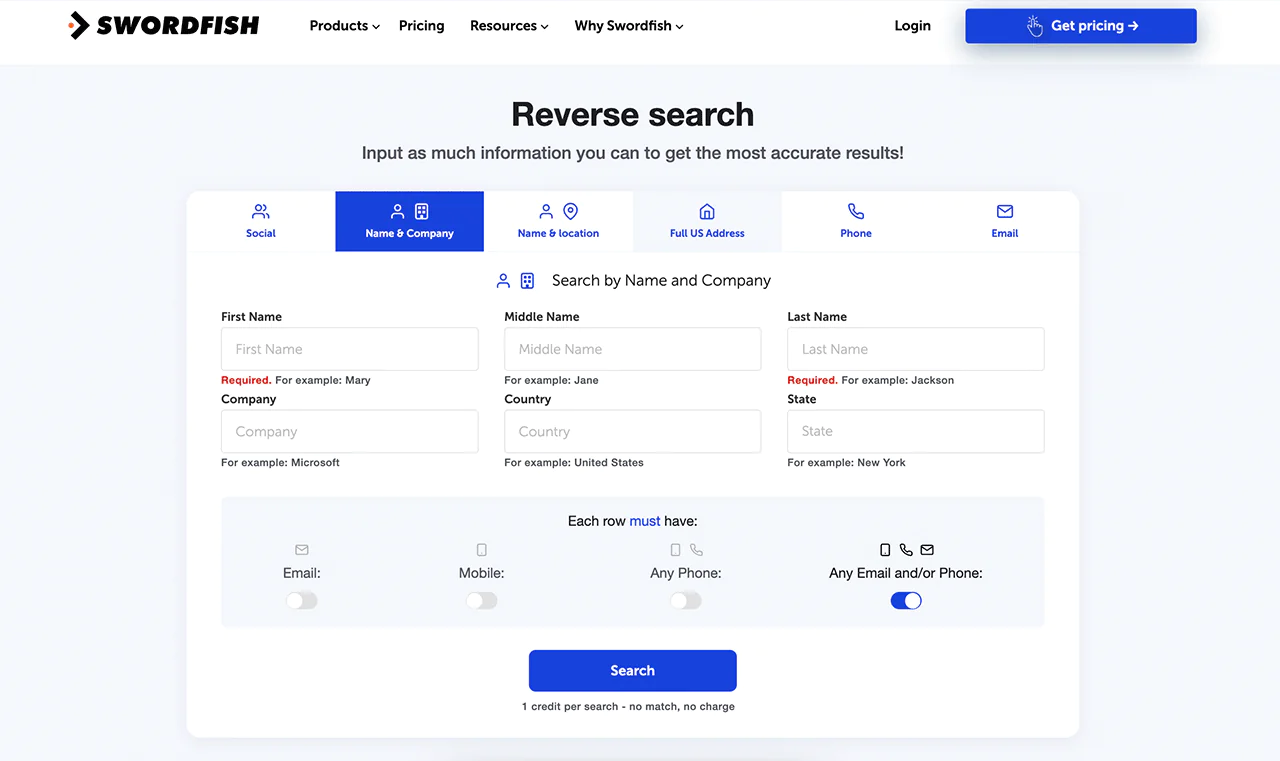
It’s not just about finding new contacts but also about enriching what you already have. With the Reverse Search feature, you can input existing data and retrieve additional information about a particular contact.
-
API Integration
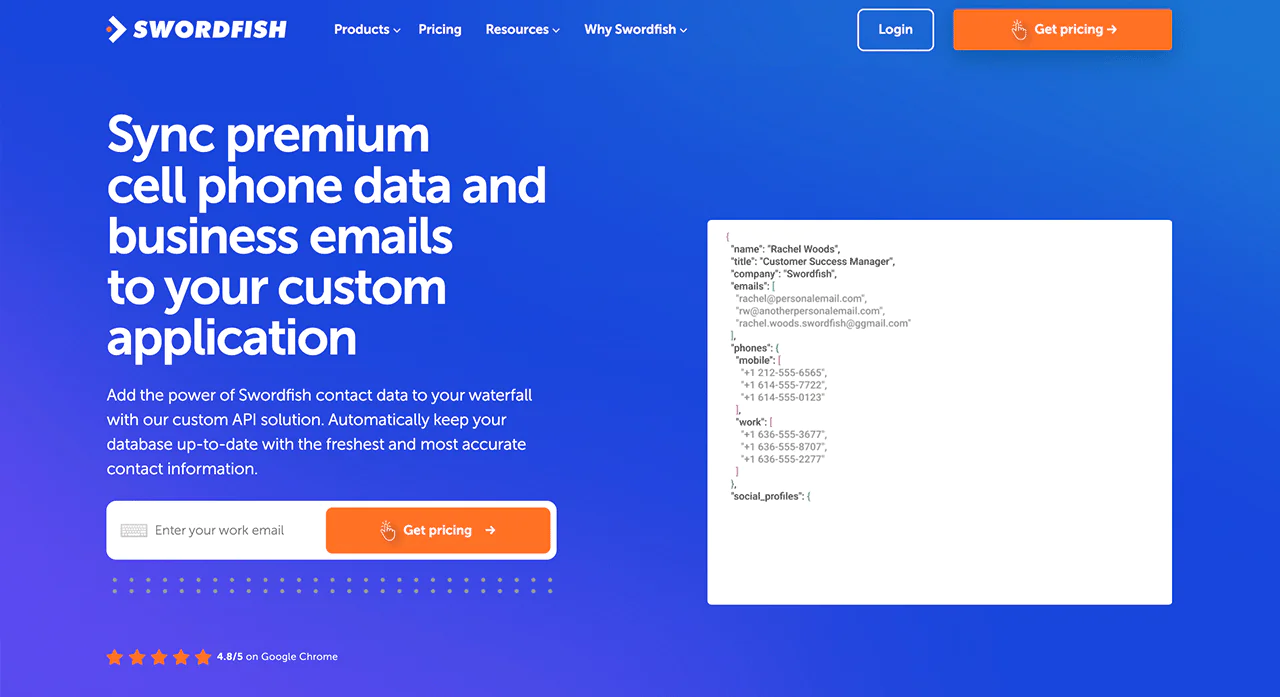
For businesses looking to scale and integrate Swordfish’s capabilities into their own applications, the API integration feature is invaluable. It ensures seamless data flow between systems.
Best Use Cases of Swordfish AI
If we compare Swordfish AI and ZoomInfo, you can use Swordfish for a variety of purposes, including —
- Direct Access for Sales Teams: Sales professionals can use Swordfish to directly reach decision-makers, bypassing intermediaries and increasing the likelihood of successful deals.
- Recruitment and Talent Acquisition: Recruiters can find accurate contact details of potential candidates, making it easier to connect and engage top talent.
- Marketing Campaigns: Marketing professionals can enrich their contact lists with Swordfish, ensuring they have the most up-to-date information for targeted campaigns.
- Business Development: Business developers can use Swordfish to identify and connect with key stakeholders in their target industries, creating partnerships and collaborations.
- Customer Research: Companies can use Swordfish to gather detailed contact information for market research and customer outreach programs.
Pricing
Swordfish AI gives you customized pricing plans suited for different industries, including sales, recruitment, marketing, and API solutions.
You can choose a package that meets your goals: bettering outbound activities, simplifying recruitment processes, marketing campaigns, or accessing specific data solutions.
Each subscription offers accurate email addresses, direct phone lines, and mobile numbers, along with regular updates on job positions and company details. To find a pricing plan that matches your business needs, just reach out for more information.
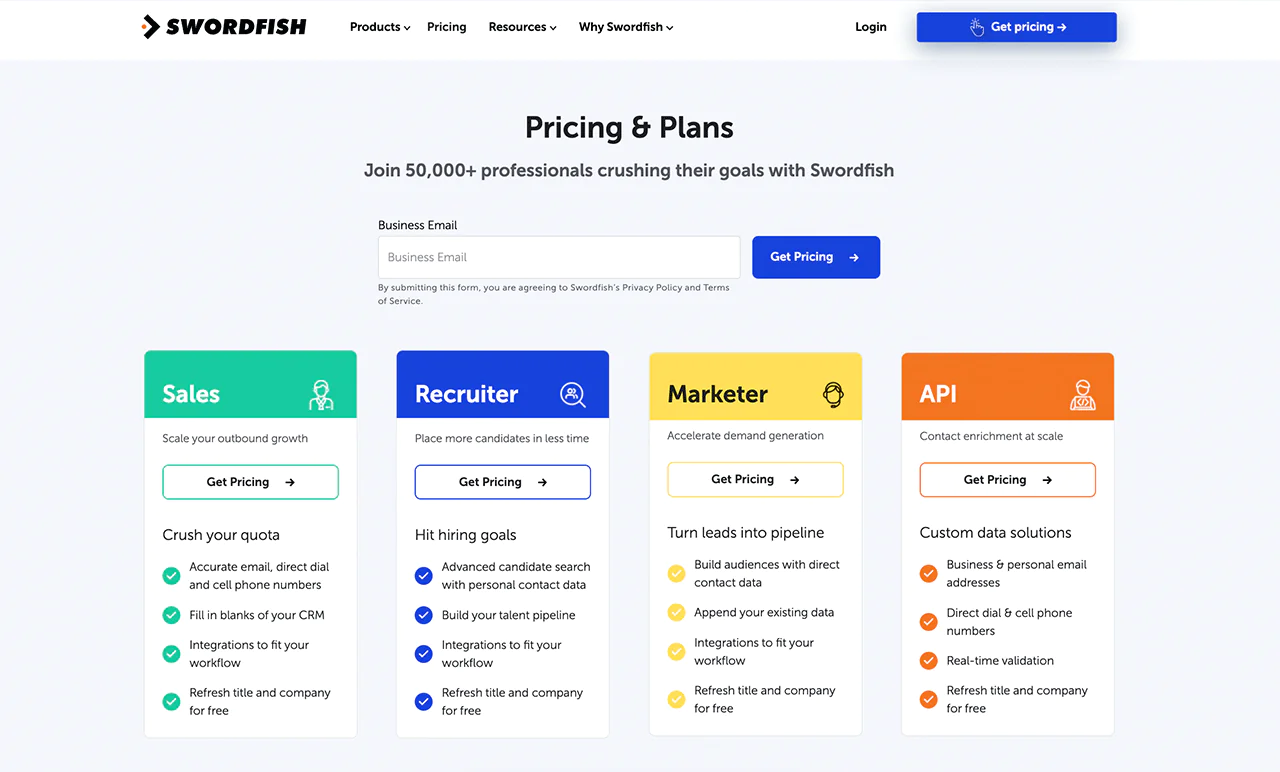
Conclusion
To conclude, what is ZoomInfo used for? The platform makes a real difference in key areas like sales, marketing, operations, and recruiting. Teams use this popular platform to scoop on customers and prospects with its huge database of enriched B2B contacts and companies.
Whether it’s closing more deals, reaching the right audiences, streamlining data, or finding top talent, ZoomInfo helps businesses work smarter and faster.
So, if you want real-time data and analytics minus the big price tag, Swordfish aims to make the same impact as ZoomInfo. Whichever route they take, platforms like these give businesses an edge with smart tech that makes sales, marketing, ops and HR teams more productive.
Note: You can also try to get started with LinkedIn Sales Navigator.
FAQs
Is ZoomInfo legal?
ZoomInfo operates within legal boundaries, adhering to data privacy laws like GDPR and CCPA, by obtaining data through compliant methods and offering opt-out options for individuals.
How does ZoomInfo get their data?
ZoomInfo gathers its data from a combination of proprietary web-crawling technology, public databases, direct partnerships, and user contributions, ensuring a broad and updated dataset while complying with data privacy regulations.
How does ZoomInfo ensure the accuracy of its data?
ZoomInfo employs machine learning and artificial intelligence to continuously update and verify its vast database. It also utilizes a combination of proprietary technology and human verification to maintain high data accuracy and reliability.
Is ZoomInfo a CRM?
ZoomInfo is not a CRM (Customer Relationship Management) system. It’s a comprehensive B2B database and sales intelligence platform that provides detailed information on businesses and professionals.
While it can integrate with various CRM systems to enrich and update contact and company data within those systems, ZoomInfo itself does not serve as a CRM platform.

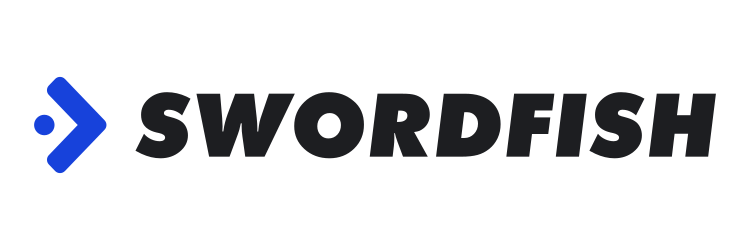
 View Products
View Products


